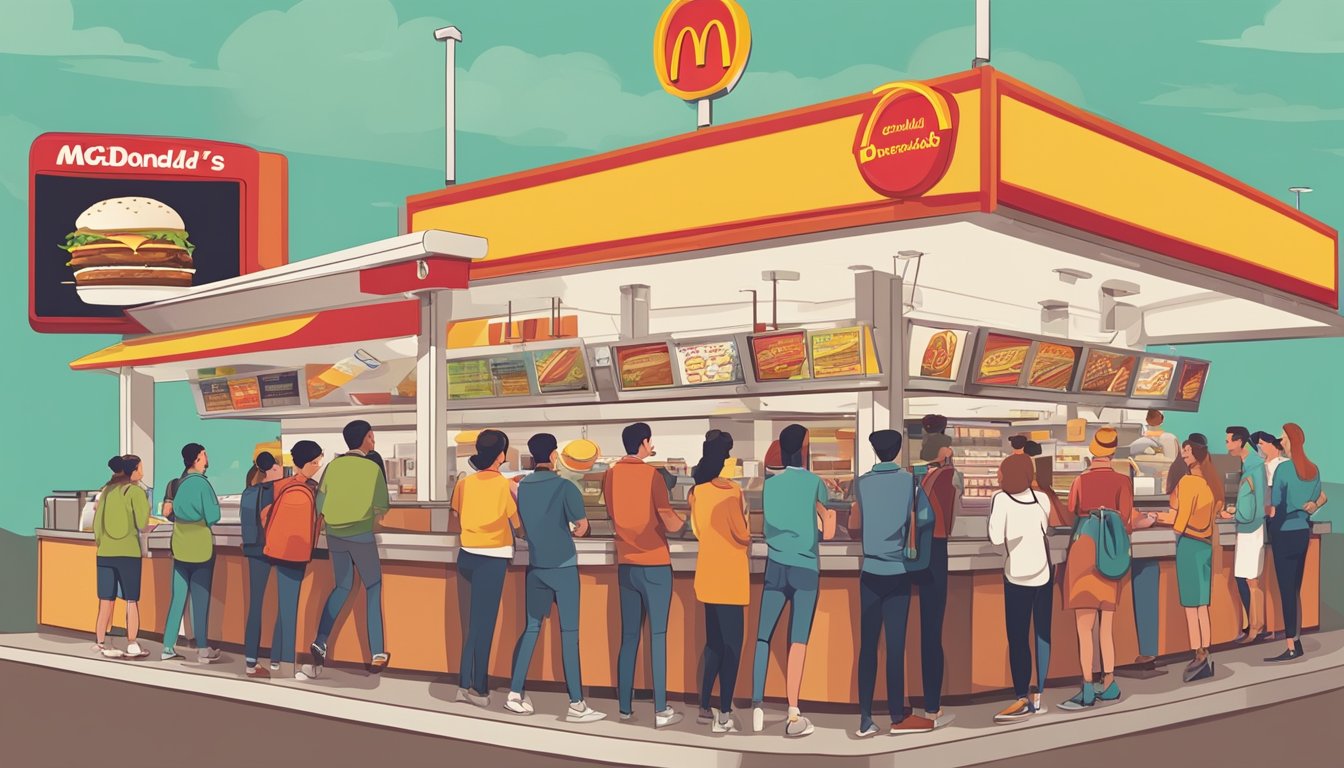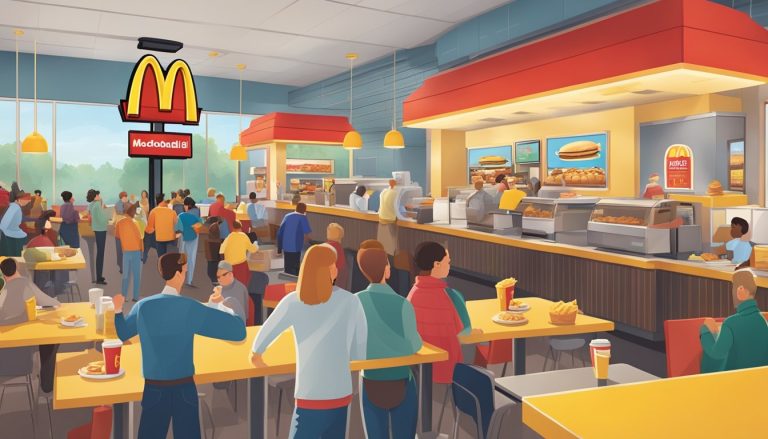McDonald’s venture into breakfast revolutionized the fast food industry and shaped morning eating habits for millions. The introduction of the Egg McMuffin in the early 1970s marked the beginning of a new era in quick-service breakfast offerings. McDonald’s innovative breakfast menu and strategic advertising campaigns transformed the way Americans viewed and consumed their first meal of the day.
Over the decades, McDonald’s has consistently evolved its breakfast menu and marketing strategies to stay ahead in the competitive fast food landscape. From the iconic Egg McMuffin to newer additions like McGriddles, the company has continually adapted to changing consumer preferences and dietary trends.
McDonald’s breakfast advertising has played a crucial role in establishing the brand as a morning destination. Through clever slogans, memorable jingles, and targeted campaigns, McDonald’s has successfully positioned itself as a convenient and tasty option for busy morning commuters and families alike. These marketing efforts have not only boosted sales but also influenced broader cultural perceptions of breakfast on-the-go.
Early Beginnings of McDonald’s
McDonald’s journey from a single restaurant to a global fast-food empire is a tale of innovation and entrepreneurship. The company’s origins, expansion, and revolutionary service system laid the groundwork for its future success in the food industry.
The McDonald Brothers and the First Restaurant
Dick and Mac McDonald opened their first restaurant in San Bernardino, California in 1940. Initially a drive-in barbecue spot, they streamlined their menu in 1948 to focus on burgers, fries, and milkshakes. This decision proved pivotal.
The brothers’ emphasis on speed and efficiency attracted large crowds. Their restaurant featured a limited menu, allowing for quicker service and lower prices. This concept revolutionized the fast-food industry.
Architect Stanley Clark Meston designed the iconic golden arches in 1953, creating a distinctive visual identity for the brand. The arches quickly became synonymous with McDonald’s restaurants across America.
Ray Kroc’s Vision and Expansion
Ray Kroc, a milkshake machine salesman, visited the McDonald brothers’ restaurant in 1954. Impressed by their operation, he saw immense potential for nationwide expansion.
Kroc convinced the brothers to let him franchise the McDonald’s concept. In 1955, he opened his first McDonald’s in Des Plaines, Illinois. This marked the beginning of rapid expansion.
Kroc’s vision extended beyond just selling burgers. He aimed to create a uniform restaurant experience across all locations. This consistency became a hallmark of the McDonald’s brand.
Development of Speedee Service System
The McDonald brothers developed the Speedee Service System in 1948. This revolutionary approach emphasized efficiency and quick service.
Key elements of the system included:
- Assembly-line food preparation
- Standardized cooking methods
- Limited menu options
- Paper products for serving
The system allowed McDonald’s to serve customers in record time. It set a new standard for fast-food operations and became a model for the entire industry.
Kroc further refined and implemented this system across all franchises, ensuring consistency and speed in every McDonald’s restaurant. This commitment to efficiency remains a core principle of McDonald’s operations today.
Introducing the Breakfast Menu
McDonald’s revolutionized the fast food industry by launching its breakfast menu in the 1970s. This strategic move tapped into a new market segment and forever changed how Americans start their day.
The Inception of the Egg McMuffin
The Egg McMuffin, introduced in 1971, marked the beginning of McDonald’s breakfast era. Herb Peterson, a McDonald’s franchise owner, created this innovative sandwich inspired by eggs benedict. The Egg McMuffin consisted of a toasted English muffin, Canadian bacon, a poached egg, and melted cheese. Its success caught the attention of McDonald’s CEO Ray Kroc, who recognized its potential to transform the breakfast landscape.
Expanding the Breakfast Offerings
In 1977, McDonald’s officially launched its national breakfast menu. The lineup included the Egg McMuffin, hotcakes, toasted English muffin, scrambled eggs, sausage, hash browns, and Danish pastries. The Big Breakfast, featuring scrambled eggs, sausage, hash browns, and a biscuit, became a hearty option for customers. Hotcakes and Sausage emerged as a popular combo, offering a sweet and savory balance. This diverse menu catered to various tastes and preferences, solidifying McDonald’s position in the breakfast market.
Marketing and Advertising Strategies
McDonald’s breakfast advertising has relied on iconic branding, evolving campaigns, and emotional connections with customers. These strategies have helped establish McDonald’s as a dominant force in the fast food breakfast market.
The Role of the Golden Arches
The Golden Arches logo has been central to McDonald’s breakfast marketing. Introduced in the 1960s, it became a universally recognized symbol of quick, convenient meals. For breakfast campaigns, the arches often appeared alongside sunrise imagery or steaming coffee cups.
McDonald’s leveraged the logo’s familiarity to promote new breakfast items. The arches featured prominently on packaging and signage, reinforcing brand recognition during morning hours.
In some ads, the arches transformed into breakfast foods, seamlessly blending the iconic symbol with menu offerings. This creative approach helped cement McDonald’s position as a go-to breakfast destination.
Advertising Campaigns Over the Decades
McDonald’s breakfast advertising has evolved significantly since the introduction of the Egg McMuffin in 1971. Early campaigns focused on convenience and affordability, targeting busy commuters and families.
In the 1980s, McDonald’s launched the “Time for Breakfast” slogan, emphasizing quick service. This campaign featured catchy jingles and showed diverse customers enjoying breakfast on the go.
The 1990s saw a shift towards quality messaging. Ads highlighted fresh ingredients and showcased menu variety. Celebrity endorsements became more common, with famous faces promoting breakfast items.
Digital advertising took center stage in the 2000s. Social media campaigns and mobile apps allowed for more targeted promotions and personalized offers for breakfast items.
Leveraging Emotional Appeal
McDonald’s breakfast advertising often taps into emotions to connect with customers. Ads frequently depict families sharing meals, emphasizing togetherness and tradition.
Nostalgia plays a key role, with campaigns reminding adults of childhood visits to McDonald’s. This strategy aims to create a sense of comfort and familiarity around breakfast offerings.
Community-focused ads showcase local franchises and their involvement in neighborhoods. These campaigns highlight McDonald’s as more than just a restaurant, but a part of customers’ daily lives.
Customer satisfaction is another emotional touchpoint. Advertisements often feature smiling patrons enjoying their meals, reinforcing positive associations with the breakfast experience.
Breakfast Sandwich Evolution
McDonald’s breakfast menu has undergone significant changes since its inception, with breakfast sandwiches playing a central role. The evolution of these offerings reflects shifting consumer preferences and the company’s commitment to innovation.
From the Egg McMuffin to McGriddles
The Egg McMuffin, introduced in 1972, marked the beginning of McDonald’s breakfast sandwich era. Created by franchise owner Herb Peterson, this iconic item featured an egg, Canadian bacon, and cheese on an English muffin. Its popularity led to the nationwide rollout of McDonald’s breakfast menu in 1977.
In 2003, McDonald’s launched McGriddles, a sweet-and-savory option combining pancake buns with traditional breakfast ingredients. This innovative sandwich catered to customers seeking a unique flavor profile and portability.
Innovation in Breakfast Offerings
McDonald’s continued to expand its breakfast sandwich lineup over the years. The Egg White Delight McMuffin, introduced in 2013, aimed to appeal to health-conscious consumers. Made with egg whites and white cheddar cheese, it offered a lower-calorie alternative to the classic Egg McMuffin.
In some markets, McDonald’s experimented with unconventional breakfast items like the Breakfast Cheeseburger. This fusion of breakfast and lunch elements showcased the company’s willingness to push boundaries and adapt to changing tastes.
McDonald’s breakfast sandwich evolution demonstrates its ability to balance tradition with innovation, maintaining customer interest through new flavors and options.
All-Day Breakfast and Its Impact
McDonald’s introduction of All-Day Breakfast in 2015 revolutionized the fast-food industry. This move responded to customer demand and reshaped breakfast market dynamics.
Consumer Demand and Business Strategy
McDonald’s decision to offer breakfast items throughout the day stemmed from persistent customer requests. Internal surveys consistently highlighted All-Day Breakfast as a top consumer desire. The company launched this initiative nationwide in October 2015, less than a year after the concept gained traction.
This strategic shift aimed to boost sales and attract new customers. By extending breakfast hours, McDonald’s tapped into a growing market of late-risers and breakfast-food enthusiasts. The move also allowed the chain to better utilize its kitchen equipment and ingredients throughout the day.
Influence on the Fast-Food Industry
All-Day Breakfast sparked a significant shift in the fast-food landscape. Competitors were forced to reevaluate their breakfast strategies in response to McDonald’s success. Many chains extended their breakfast hours or introduced new all-day breakfast items to remain competitive.
This industry-wide change expanded consumer choices and blurred traditional mealtime boundaries. Fast-food chains saw increased foot traffic during non-peak hours. The breakfast market grew as a result, with more customers opting for breakfast items at unconventional times.
The impact extended beyond menu offerings. Restaurants had to adapt their operations, staff training, and kitchen layouts to accommodate the new service model. This shift highlighted the importance of flexibility and customer-centric strategies in the fast-food industry.
Understanding McDonald’s Breakfast Culture

McDonald’s breakfast offerings have become deeply ingrained in American culture, shaping morning routines and influencing the fast food industry. The company’s breakfast menu has evolved into a social phenomenon, sparking competition and fostering community connections.
Breakfast as a Community Event
McDonald’s breakfast has transformed into a shared experience for many. Locations often serve as gathering spots for regulars, from retirees to working professionals. These morning meetups create a sense of belonging and routine.
Some restaurants host community events centered around breakfast. Local sports teams and school groups frequently use McDonald’s as a pre-game meal spot. The affordability and consistency of the menu make it an accessible option for diverse groups.
The familiar golden arches beckon to travelers, providing a taste of home even in unfamiliar places. This universal appeal has helped establish McDonald’s breakfast as a cultural touchstone.
The Breakfast Wars and Market Competition
McDonald’s dominance in the breakfast market has sparked fierce competition. Rival chains have expanded their morning menus in response, leading to what industry insiders call the “Breakfast Wars.”
Key battlegrounds include:
- Menu innovation
- Extended serving hours
- Value pricing
- Coffee quality
McDonald’s has responded with strategic moves:
- Introducing all-day breakfast in 2015
- Enhancing coffee offerings
- Launching limited-time promotions
These competitive pressures have benefited consumers through increased choices and improved quality. The breakfast segment now represents a significant portion of many fast food chains’ revenue, highlighting its importance in the market.
Quality and Efficiency in the Spotlight
McDonald’s breakfast advertising has long emphasized the quality of ingredients and operational efficiency. These core elements have been key selling points in promoting the chain’s morning offerings.
Emphasis on Ingredients and Supply Chain
McDonald’s breakfast ads often highlight the quality and freshness of ingredients. Campaigns showcase eggs cracked fresh daily and premium coffee sourced from sustainable farms. The company emphasizes its rigorous supplier standards and quality control measures.
In recent years, McDonald’s has focused on transparency in its supply chain. Advertisements feature farmers and suppliers, putting faces to the ingredients. This approach aims to build trust and address consumer concerns about food sourcing.
The chain also promotes its efforts to use cage-free eggs and antibiotic-free chicken in breakfast items. These initiatives are prominently featured in marketing materials to appeal to health-conscious customers.
Service with Speed and Its Historical Importance
Speed of service has been a cornerstone of McDonald’s breakfast advertising since the 1970s. Early campaigns emphasized the convenience of grabbing a quick, hot breakfast on the way to work.
The introduction of the Egg McMuffin in 1972 revolutionized fast-food breakfast. Ads touted it as a complete, portable meal that could be eaten on-the-go. This concept of speed and convenience became central to McDonald’s breakfast identity.
Over the years, McDonald’s has continually improved its breakfast service times. Ads often feature clock imagery or time-lapse sequences to illustrate quick preparation. The company has invested in kitchen technology and staff training to maintain its reputation for fast service.
Drive-thru efficiency is frequently highlighted in breakfast commercials. McDonald’s promotes its ability to serve hot, fresh breakfast to customers without them leaving their cars.
Financial Growth and Market Presence

McDonald’s financial journey has been marked by significant milestones and impressive global expansion. The company’s strategic decisions and market positioning have played crucial roles in its continued success.
The Significance of the IPO
McDonald’s initial public offering in 1965 marked a turning point for the company. This move transformed McDonald’s from a private enterprise to a publicly traded corporation. The IPO raised substantial capital, enabling McDonald’s to fund aggressive expansion plans.
The influx of investment allowed McDonald’s to accelerate its growth strategy. New restaurants opened rapidly across the United States and internationally. This period saw McDonald’s solidify its position as a dominant player in the fast-food industry.
Gross Sales and Global Presence
McDonald’s global sales figures have consistently demonstrated the company’s market strength. By 2024, McDonald’s operated over 40,000 locations worldwide. This extensive network spans more than 100 countries, showcasing the brand’s international appeal.
The franchise model has been a key driver of McDonald’s expansion. Approximately 93% of McDonald’s restaurants are franchised, reducing corporate risk while maintaining brand consistency. This approach has allowed for rapid growth and adaptability to local markets.
Annual gross sales have reached impressive heights, often exceeding $20 billion. McDonald’s market capitalization regularly places it among the top publicly traded restaurant chains globally. The company’s financial success is reflected in its consistent dividend payments to shareholders.
Looking Forward: Evolving with Consumer Trends
McDonald’s breakfast offerings continue to adapt to changing consumer preferences and technological advancements. The company focuses on meeting health-conscious demands while leveraging digital innovations to enhance customer experiences.
Adapting to Health-Conscious Consumers
McDonald’s has introduced healthier breakfast options to cater to nutrition-focused customers. The menu now includes items like fruit and maple oatmeal, egg white delight McMuffins, and yogurt parfaits. These choices provide lower-calorie alternatives to traditional breakfast fare.
The company has also increased transparency by displaying calorie information on menu boards. This helps customers make informed decisions about their meal choices.
McDonald’s sources ingredients more carefully, emphasizing quality and sustainability. The shift includes using cage-free eggs and removing artificial preservatives from certain breakfast items.
Technological Innovation in Service
McDonald’s embraces digital technology to streamline breakfast service and improve customer satisfaction. The McDonald’s mobile app allows customers to place breakfast orders in advance for quick pickup.
Self-service kiosks in restaurants provide a convenient way for customers to customize their breakfast orders. This reduces wait times and enhances order accuracy.
The company is exploring AI-driven menu boards that can suggest breakfast items based on factors like weather, time of day, and popular choices. This personalized approach aims to improve the overall breakfast experience.
McDonald’s also utilizes data analytics to optimize its breakfast menu offerings and pricing strategies. This helps the company stay responsive to changing consumer preferences and market trends.




